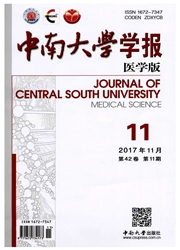

 中文摘要:
中文摘要:
目的:探讨LRRC4(1eucine-rich repeats containing4)通过SDF-1α/CXCR4(stromal cell-derived factor-1α/CXC receptor4)对脑胶质瘤细胞侵袭迁移能力的影响。方法:将LRRc4基因转入脑胶质母细胞瘤U251细胞,分别通过RT-PCR实验、黏附实验、侵袭实验、细胞运动试验、划痕标记荧光染料示踪实验.研究SDF-1α干预前后LRRC4对U251细胞迁移能力的影响。结果:将LRRC4基因转入脑胶质瘤细胞U251,通过RT-PCR实验发现CXCR4的表达下调。用CXCR4的特异配体SDF-1α干预后,肿瘤黏附内皮实验、侵袭实验、细胞迁移实验、划痕标记染料示踪实验表明脑胶质瘤细胞迁移能力增强,LRRC4可以抑制细胞的这种侵袭迁移能力。SDF-1α能够改善细胞间的通讯能力,LRRC4可以进一步增强这种通讯能力。结论:SDF-1α/CXCR4的相互作用可以增强脑胶质瘤细胞U251的运动迁移能力,LRRC4基因可以通过调控SDF-1α/CXCR4生物学轴有效地抑制肿瘤细胞的侵袭迁移能力。
 英文摘要:
英文摘要:
Objective To exolore the effect of LRRC4 on the mobility and invasion of glio-blastomas U251 cells through the SDF-1α/CXCR4 axis. Methods RT-PCR, transfiher cell invasion assay, adhesion assay, scraping test, scrape loading, and dye transfer assay were used to determine the effect of LRRC4 on U251 cells. Results SDF-1α could increase the invasion in U251 which expressed CXCR4. The reintroduction of LRRC4 in U251 cells could inhibit the expression of CXCR4. LRRC4 also inhibited the adhesion ability of U251 to ECV304 as well as the mobility and invasion ability in vitro, which was mediated by the SDF-1α/CXCR4 axis. Furthermore, LRRC4 could greatly enhance the gap junctional intercellar communication of U251 cells .Conclusion The reintroduction of LRRC4 in U251 cells can inhibit the expression of CXCRd and the SDF-1α/CXCR4 axis-mediated cell invasion in vitro.
 同期刊论文项目
同期刊论文项目
 同项目期刊论文
同项目期刊论文
 Profiling and Comparing Transcription Factors Activated in Non-Metastatic and Metastatic Nasopharyng
Profiling and Comparing Transcription Factors Activated in Non-Metastatic and Metastatic Nasopharyng Synergistic effect of indomethacin and NGX6 on proliferation and invasion by human colorectal cancer
Synergistic effect of indomethacin and NGX6 on proliferation and invasion by human colorectal cancer LRRC4 inhibits human glioblastoma cells proliferation, invasion, and proMMP-2 activation by reducing
LRRC4 inhibits human glioblastoma cells proliferation, invasion, and proMMP-2 activation by reducing 期刊信息
期刊信息
